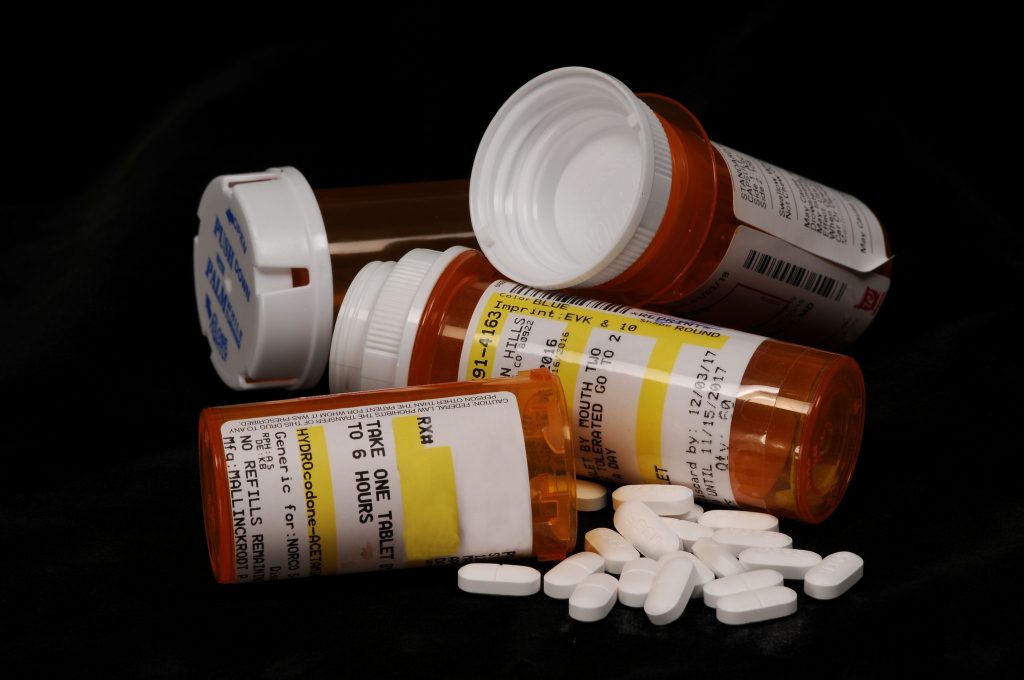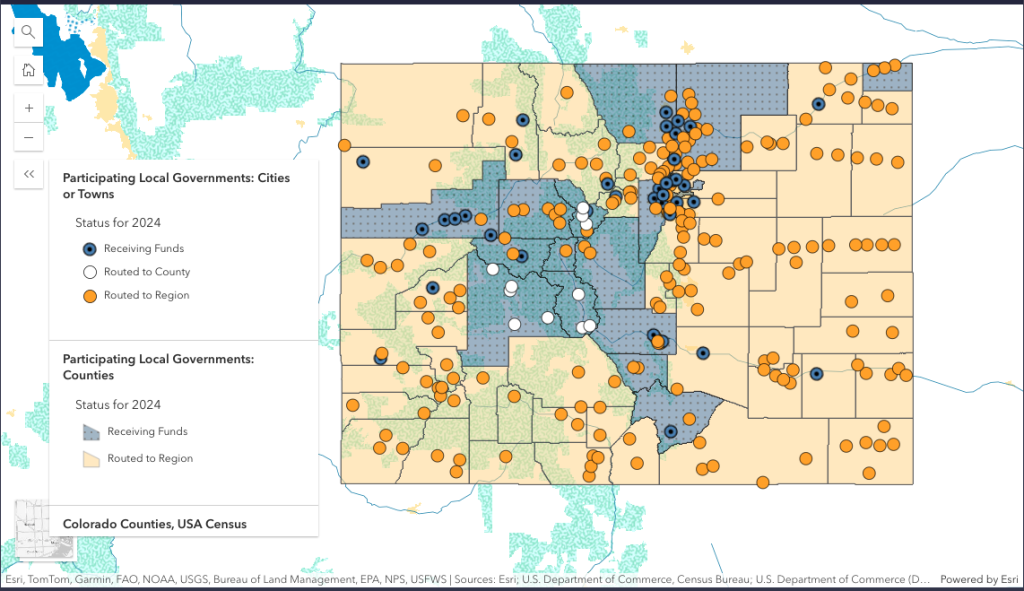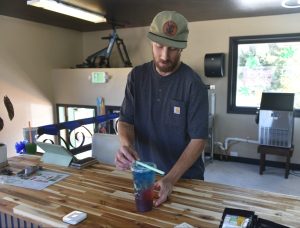How Colorado mountain communities are using national opioid settlement dollars to understand the local impact of epidemic
Newly compiled data identifies substance use, overdose and other opioid-related trends in Pitkin, Eagle, Summit, Lake and Garfield counties

“Opioids” by K-State Research and Extension, CC BY 2.0
Colorado is expected to receive over $880 million in funds from national opioid settlements with pharmaceutical companies. With the majority of the funds going directly to local communities and regions to tackle the opioid crisis on the ground, one group of mountain counties is leveraging the dollars to better understand how the epidemic is hitting their communities.
Pitkin, Eagle, Summit, Lake and Garfield counties recently launched a dashboard to build a more data-driven and robust picture of what the opioid crisis is doing along the Interstate 70 mountain corridor. The counties comprise one of Colorado’s 19 opioid abatement regions, designated Region 5, formed for the distribution of the settlement dollars.
When the region was originally set by the state as it determined how it would distribute the funds, officials from the five counties guiding the opioid abatement council wanted to understand the various needs facing their communities as a result of the opioid crisis.
“We have Eagle, Summit, and Pitkin counties, which are affluent ski resort communities with a really high cost of living, more of a party culture and recreational approach to substance use culturally,” said Karina Schorr, the administrator for Region 5’s council. “And then Lake and Garfield both have really high-need, lower-income, rural areas, as well as a lot of their population being workforce for Eagle, Pitkin and Summit counties.”
With each county’s broad and diverse needs, services and demographics, the council wanted to evaluate from a data perspective, Schorr added.
The region launched the resulting data dashboard this summer using some of the funds it has received from Colorado’s portion of the national opioid settlements.
The dashboard tracks various aspects of how the opioid crisis is hitting communities, starting with social determinants of health or upstream factors such as income, employment, housing stability, food stability and more. It also shows outcomes of the opioid epidemic from justice system involvement, fatal and non-fatal overdoses and youth-specific substance use behavior and attitude data.
Looking at the impact of opioids along Colorado’s I-70 mountain corridor

Much of the data tracking outcomes of the opioid crisis on the dashboard relies on rates, which are calculated per a certain number of individuals. The latest 2023 census data on the dashboard estimates the population of Garfield County at 62,707, Eagle County at 54,381, Summit at 30,465, Pitkin at 16,640 and Lake at 7,365.
Opioid prescription rates
The United States’ opioid crisis ramped up in the late 1990s and early 2000s as health care providers began increasingly prescribing opioids based largely on pharmaceutical companies’ assurances of low addiction risk for the drugs. The nationwide opioid settlements are aimed at holding these companies responsible for the resulting outcomes as the epidemic took hold.
In 2020 — the most recent year on the dashboard for this data set — 47.8 out of every 100 people were prescribed an opioid in Eagle County. This was the highest rate in the region that year, followed by 30 out of every 100 people in Garfield County, 28.2 in Summit, 27.9 in Pitkin and 11.3 in Lake.
Across Colorado, during 2020, 37.3 out of every 100 individuals were prescribed an opioid, compared to 43.3 out of every 100 in the U.S.
The dashboard shows prescription rates back to 2016. While the statewide rate declined slightly from 2016 to 2020, it decreased significantly in Garfield County, where 80 out of every 100 individuals were prescribed an opioid in 2016. Lake County also experienced a decline from around 50 out of every 100 people in 2016. Summit County decreased from around 60 people per 100 in 2016 to almost half of that in 2020.
Eagle and Pitkin counties remained relatively flat during the period, but both saw an increase between 2018 and 2019 and maintained a similar rate in 2020.
Law enforcement outcomes
For the seven years of data shown on the dashboard, from 2018 to 2024, Garfield County had the highest rate of drug and narcotic-involved violations, peaking in 2019 with 44.5 violations per 10,000 individuals. The rate declined in each subsequent year in the county.
Between 2018 and 2021, Eagle County had the second-highest rate of violations involving drugs and narcotics. The county saw its highest rate in 2018, hitting 27 violations per 10,000 individuals and has declined every year since in the county to 6.3 violations per 10,000 individuals in 2024.
In 2022, Summit County had more violations per 10,000 individuals than Eagle County, but was still lower than Garfield. Summit County saw its highest rate in 2022, with 18 violations per 10,000 people. In 2023 and 2024, this rate declined, hitting around nine violations per 10,000 in 2024.
In 2023, violations in Lake County jumped to nearly 33 violations per 10,000 people, up from 8.2 violations per 10,000 individuals in the year prior. This rate dropped back to a rate of 16 violations per 10,000 individuals in 2024, but was still the highest in the region for that year.
Lake County and Pitkin County had the lowest rates between 2018 and 2022 among the five counties in Region 5.
In all seven years, stimulants — which include substances like amphetamines, cocaine and methamphetamines — accounted for the most drug seizures in the region. Marijuana/hashish and narcotics accounted for the second- and third-most seizures. Violations for possession or concealment of substances were the most common in the region between 2018 and 2024.
Violations for all seven years were highest among males and those 18 to 24 years old. This was followed closely by individuals between the ages of 25 and 34.
Overdoses
While the rate of non-fatal overdoses per 100,000 in Region 5 was slightly lower than the statewide rate between 2016 and 2023, it followed a similar, relatively flat trend as the state.
Garfield, Eagle, Pitkin and Summit counties also individually remained relatively flat during the time period shown on the dashboard. Garfield County experienced the most non-fatal overdoses in 2022, with 119 recorded. Pitkin County recorded 17 in 2020, marking its highest year for non-fatal overdoses. For Eagle County, 2022 was its highest year with 63 recorded. Summit County recorded 46 in 2021.
Lake County experienced more variation than the state, region and other counties in the region between 2016 and 2023. The county recorded 20 non-fatal overdoses in 2016 and 2022. The low for this period was in 2020 with 12 recorded. The trend jumps up and down between each other year.
Lake County also experienced the highest number of fatal overdoses between 2020 and 2022 — the only years for this dataset on the dashboard. It saw nearly 50 fatal overdoses per 100,000 people.
This was compared to Colorado’s statewide rate of nearly 30 fatal overdoses per 100,000 people and the region’s rate of 17 per 100,000 individuals.
The other four counties in Region 5 had the following rate of fatal overdoses per 100,000 people during the three years displayed:
- Pitkin County: 21.34
- Garfield County: 19.87
- Summit County: 17.27
- Eagle County: 7.80
Tracking the region’s goals

The dashboard also creates a way for the region’s council to track its progress. From the start, the opioid abatement council in Region 5 set five priorities: reduce the number of deaths related to substance use; increase the number of people seeking help for substance use disorders; increase community awareness of substance use risks, understanding of local needs and gaps, and where to find resources and support; increase the availability of and knowledge surrounding harm reduction services; and increase the potential for winning grants and other funding sources.
For example, the region launched an anti-stigma and education campaign called Community Compass. The dashboard will allow the group to track how stigma factors into regional attitudes, beliefs, and behaviors around substance use. Additionally, it will track the distribution and progress of harm reduction services and products such as Narcan (a nasal spray used to reverse opioid overdoses), fentanyl test strips, syringe exchange programs and more.
As more funds are distributed and used to infuse funding via grants into the communities directly, Schorr noted that the dashboard will serve as an added resource for local organizations seeking these grants.
“A lot of the data that is included on the dashboard was obtained from private sources and wouldn’t really otherwise be available to organizations in Region 5,” she said. “We hope that it is going to help when other organizations in these communities go to apply for funding.”
Region 5 is currently accepting applications for two grants: one for youth programming and another for treatment and recovery systems.
How Colorado is distributing opioid settlement funds

In Colorado, the funds received by the state from the pharmaceutical settlements are distributed across 19 regions and local municipalities that signed on to receive the settlement dollars. Sixty percent of funds go toward the regional opioid abatement councils, 20% go to local governments, 10% to abatement infrastructure, and 10% to the state.
The local governments that sign on to the settlements can spend their allocations or choose to cede them to their county or region.
In Region 5, all five counties have selected to keep their funds.
The region’s municipalities have chosen various paths. Glenwood Springs, Leadville, Vail, Red Cliff, Minturn, Eagle, Gypsum, Basalt, Snowmass Village and Blue River have routed their funds to the regional council. Aspen, Carbondale, Parachute, Rifle, Silt, New Castle and and Dillon have elected to keep their portions. Silverthorne, Frisco and Breckenridge have all routed their funds to Summit County.
The first round of Colorado’s opioid settlement funds was distributed in 2022. By Dec. 31, 2024 — the date of the most recent distribution — $77.6 million has been distributed to the regions, with a total $474.9 million expected to go to the regions by 2038. By the end of 2024, local governments received $18.3 million, with $64.5 million anticipated by 2038.
As of May 2025, Region 5’s total share of funds was projected to be around $2.3 million, with over $9.1 million expected by 2038.
Counties and municipalities can currently sign on to receive their portion of the latest settlement with Purdue Pharma, the company’s owners and members of the Sackler family for their role in the opioid crisis. Colorado is expected to receive $75.67 million of this total $7.4 billion settlement.
This money can be used for five areas: prevention and education, treatment, recovery, harm reduction and criminal justice.

Support Local Journalism

Support Local Journalism
As a Summit Daily News reader, you make our work possible.
Summit Daily is embarking on a multiyear project to digitize its archives going back to 1989 and make them available to the public in partnership with the Colorado Historic Newspapers Collection. The full project is expected to cost about $165,000. All donations made in 2023 will go directly toward this project.
Every contribution, no matter the size, will make a difference.










